Related Research Articles

The 1974 Super Outbreak was the second-largest tornado outbreak on record for a single 24-hour period, just behind the 2011 Super Outbreak. It was also the most violent tornado outbreak ever recorded, with 30 F4/F5 tornadoes confirmed. From April 3–4, 1974, there were 148 tornadoes confirmed in 13 U.S. states and the Canadian province of Ontario. In the United States, tornadoes struck Illinois, Indiana, Michigan, Ohio, Kentucky, Tennessee, Alabama, Mississippi, Georgia, North Carolina, Virginia, West Virginia, and New York. The outbreak caused roughly $843 million USD in damage, with more than $600 million occurring in the United States. The outbreak extensively damaged approximately 900 sq mi (2,331 km2) along a total combined path length of 2,600 mi (4,184 km). At one point, as many as 15 separate tornadoes were occurring simultaneously.
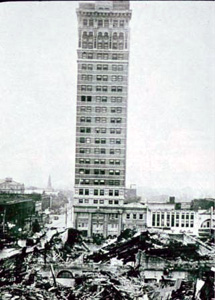
A deadly series of at least 33 tornadoes hit at least 10 different U.S. states on May 9–11, 1953. Tornadoes appeared daily from Minnesota in the north to Texas in the south. The strongest and deadliest tornado was a powerful F5 tornado that struck Waco, Texas on May 11, causing 114 of the 144 deaths in the outbreak. Alongside the 1902 Goliad tornado, it was the deadliest tornado in Texas history and is the 11th deadliest tornado in U.S. history. The tornado's winds demolished more than 600 houses, 1,000 other structures, and over 2,000 vehicles. 597 injuries occurred, and many survivors had to wait more than 14 hours for rescue. The destruction dispelled a myth that the geography of the region spared Waco from tornadoes, and along with other deadly tornadoes in 1953, the Waco disaster was a catalyst for advances in understanding the link between tornadoes and radar-detected hook echoes. It also generated support for improved civil defense systems, the formation of weather radar networks, and improved communications between stakeholders such as meteorologists, local officials, and the public.

The tornado outbreak sequence of May 2004 was a series of tornado outbreaks that affected much of southern Ontario, the Central and Southern United States from east of the Rockies to the Mid-Atlantic States from May 21 to May 31, 2004. Particularly hard hit were the central Plains from Missouri to Iowa and the Ohio Valley. The Central Plains were hit by two significant outbreaks on May 22 and May 24, the first outbreak of which produced a very large and violent tornado in Hallam, Nebraska. The Ohio Valley was affected by one of the largest tornado outbreaks ever during the Memorial Day weekend on May 29–30.

Tropical Storm Bill was a tropical storm that affected the Gulf Coast of the United States in the summer of 2003. The second storm of the 2003 Atlantic hurricane season, Bill developed from a tropical wave on June 29 to the north of the Yucatán Peninsula. It slowly organized as it moved northward, and reached a peak of 60 miles per hour (97 km/h) shortly before making landfall in south-central Louisiana. Bill quickly weakened over land, and as it accelerated to the northeast, moisture from the storm, combined with cold air from an approaching cold front, produced an outbreak of 34 tornadoes. Bill became extratropical on July 2, and was absorbed by the cold front later that day.
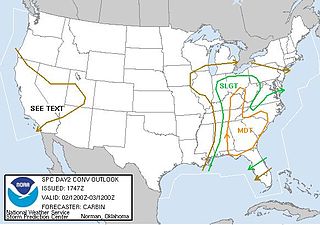
The tornado outbreak of January 1–2, 2006, was one of the largest tornado outbreaks ever recorded in the month of January. The outbreak affected much of the Central and Southern United States and produced 20 tornadoes. The tornadoes caused considerable damage in the states of Kentucky and Georgia. There were no tornado related fatalities and only minor injuries were reported.
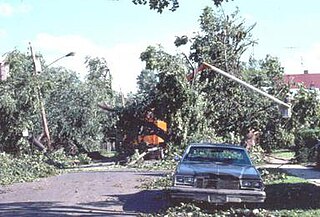
A destructive series of tornadoes in damage struck the Northeastern United States on July 10, 1989. The storm system affected five states with severe weather, including hail up to 2.5 inches (6.4 cm) across, thunderstorm winds up to 90 mph (140 km/h), and 17 tornadoes. Several towns in New York and Connecticut were particularly hard-hit. Several homes were leveled in Schoharie, New York, and extensive damage occurred in Bantam, Connecticut. A large section of Hamden, Connecticut, including an industrial park and hundreds of homes, was destroyed, and in some places, buildings were flattened to the ground.
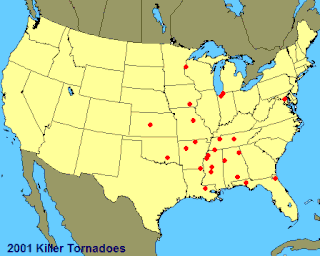
This page documents notable tornadoes and tornado outbreaks worldwide in 2001. Strong and destructive tornadoes form most frequently in the United States, Bangladesh, and Eastern India, but they can occur almost anywhere under the right conditions. Tornadoes also develop occasionally in southern Canada during the Northern Hemisphere's summer and somewhat regularly at other times of the year across Europe, Asia, and Australia. Tornadic events are often accompanied with other forms of severe weather, including strong thunderstorms, strong winds, and hail.

This page documents the tornadoes and tornado outbreaks of 1999, primarily in the United States. Most tornadoes form in the U.S., although some events may take place internationally, particularly in parts of neighboring southern Canada during the Northern Hemisphere's summer season, as well as Europe. One particular event, the Bridge Creek-Moore, Oklahoma F5 tornado, produced the highest wind speed ever recorded on Earth, which was 301 ± 20 mph (484 ± 32 km/h).

The 2006 Westchester County tornado was the strongest and largest tornado in Westchester County, New York since the 1904 Chappaqua tornado. It touched down there on Wednesday, July 12, 2006, and traveled 13 miles (21 km) into southwestern Connecticut during a 33-minute span through two states. The tornado touched down at 3:30 p.m. EDT (19:30 UTC) on the shore of the Hudson River before becoming a waterspout and traveling 3 mi (5 km) across the river. Coming ashore, the tornado entered Westchester County and struck the town of Sleepy Hollow at F1 intensity. After passing through the town, it intensified into an F2 tornado and grew to almost a one-quarter mile (400 m) in diameter. The tornado continued through the county, damaging numerous structures, until it crossed into Connecticut at 4:01 p.m. EDT (20:01 UTC). Not long after entering the state, it dissipated in the town of Greenwich at 4:03 p.m. EDT (20:03 UTC). When the tornado entered Westchester County, it was the eighth known tornado to either touch down or enter the county since 1950.
The May 2009 derecho series was an unusually strong sequence of derecho events and tornadoes beginning on May 2, 2009, and continuing through May 8, which primarily affected the Southern United States. At least seven people were killed by the storms. An associated tornado outbreak also resulted in nearly 100 tornadoes, some strong, with most strong tornadoes, most damage, and all of the deaths on May 8. In total, nine people were killed, dozens were injured and at least $70 million in damage occurred, $58 million on May 8.

The May 2009 Southern Midwest Derecho was an extreme progressive derecho and mesoscale convective vortex (MCV) event that struck southeastern Kansas, southern Missouri, and southwestern Illinois on May 8, 2009. Thirty-nine tornadoes, including two of EF3 strength on the Enhanced Fujita Scale, were reported in addition to high non-tornadic winds associated with the derecho and MCV. Due to the abnormal shape of the storm on radar and the extremely strong winds, many called this an "inland hurricane." A new class of storm, the Super Derecho, has been used to describe this event after analysis in 2010. Embedded supercells produced hail up to baseball size in southern Missouri, a rare event in a derecho. A wind gust of 106 mph (171 km/h) was recorded by a backup anemometer at the Southern Illinois Airport after official National Weather Service equipment failed. This derecho was the last of a series of derechos that occurred at the beginning of May.
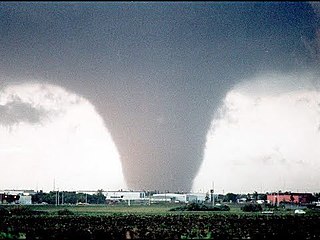
This page documents the tornadoes and tornado outbreaks of 1987, primarily in the United States. Most tornadoes form in the U.S., although some events may take place internationally. Tornado statistics for older years like this often appear significantly lower than modern years due to fewer reports or confirmed tornadoes.

The tornado outbreak of April 22–25, 2010 was a multi-day tornado outbreak across a large portion of the Southern United States, originally starting in the High Plains on April 22, 2010, and continuing through the Southern Plains on April 23, and the Mississippi and Tennessee Valleys on April 24. The most severe activity was on April 24, particularly in Mississippi. The outbreak was responsible for ten tornado-related fatalities on April 24, all in Mississippi from a single supercell that crossed the entire state.

This page documents the tornadoes and tornado outbreaks of 1996, primarily in the United States. Most tornadoes form in the U.S., although some events may take place internationally. Tornado statistics for older years like this often appear significantly lower than modern years due to fewer reports or confirmed tornadoes, however by the 1990s tornado statistics were coming closer to the numbers we see today.

From April 14–16, 2011, a tornado outbreak, among the largest recorded tornado outbreaks in U.S. history, produced 178 confirmed tornadoes across 16 states, resulting in severe destruction on all three days of the outbreak. A total of 38 people were killed from tornadoes and an additional five people were killed as a result of straight-line winds associated with the storm system. The outbreak of severe weather and tornadoes led to 43 deaths in the Southern United States. This was the largest number of fatalities in an outbreak in the United States since the 2008 Super Tuesday tornado outbreak. It is locally referred to as the "Forgotten Outbreak" in Alabama as it was vastly overshadowed by the 2011 Super Outbreak less than two weeks later.

The 2011 Super Outbreak was the largest, costliest, and one of the deadliest tornado outbreaks ever recorded, taking place in the Southern, Midwestern, and Northeastern United States from April 25 to 28, 2011, leaving catastrophic destruction in its wake. Over 175 tornadoes struck Alabama, Mississippi, and Tennessee, which were the most severely damaged states. Other destructive tornadoes occurred in Arkansas, Georgia, Kentucky, Louisiana, New York, and Virginia, with storms also affecting other states in the Southern and Eastern United States. In total, 360 tornadoes were confirmed by NOAA's National Weather Service (NWS) and Government of Canada's Environment Canada in 21 states from Texas to New York to southern Canada. Widespread and destructive tornadoes occurred on each day of the outbreak. April 27 was the most active day, with a record 216 tornadoes touching down that day from midnight to midnight CDT. Four of the tornadoes were rated EF5, which is the highest ranking on the Enhanced Fujita scale; typically these tornadoes are recorded no more than once a year.

On March 2 and 3, 2012, a deadly tornado outbreak occurred over a large section of the Southern United States into the Ohio Valley region. The storms resulted in 41 tornado-related fatalities, 22 of which occurred in Kentucky. Tornado-related deaths also occurred in Alabama, Indiana, and Ohio. The outbreak was the second deadliest in early March for the U.S. since official records began in 1950; only the 1966 Candlestick Park tornado had a higher death toll for a tornadic system in early March.
This page documents the tornadoes and tornado outbreaks of 1951, primarily in the United States. Most tornadoes form in the U.S., although some events may take place internationally. Tornado statistics for older years like this often appear significantly lower than modern years due to fewer reports or confirmed tornadoes.

The first six days of December 1953 produced a destructive and deadly tornado outbreak sequence across the Southern United States. There were 19 confirmed tornadoes, including a violent F4 tornado that hit the northwest side of Alexandria, Louisiana and even more violent F5 tornado that hit Vicksburg, Mississippi. In all, the tornadoes killed 49 people, injured 404 others, and caused $45,709 million in damage. The death toll made this deadliest December tornado outbreak ever recorded and it would not be surpassed until 2021. This was also the last of the series of deadly and catastrophic tornado outbreaks to strike the US in 1953.
References
- 1 2 "NCDC Query Output". National Climatic Data Center. 2008-04-06. Archived from the original on 2010-05-06. Retrieved 2008-04-06.
- ↑ National Weather Service Office Louisville, Kentucky. Public Information Statement. Archived 2007-03-10 at the Wayback Machine Retrieved on 2006-10-24.
- ↑ Shafer, Sheldon (June 4, 1996). "Forest lost thousands of big trees to tornado". The Courier-Journal . p. 1. Retrieved May 9, 2024.
- ↑ National Climatic Data Center. Event Record Details. Retrieved on 2006-10-24.
- ↑ "Tornadogenesis in High-end Tornadic Supercells (Part 3) Moore, Oklahoma EF5 on May 20, 2013 A Case Representative of Tornadogenesis" (PDF). Retrieved 11 January 2023.